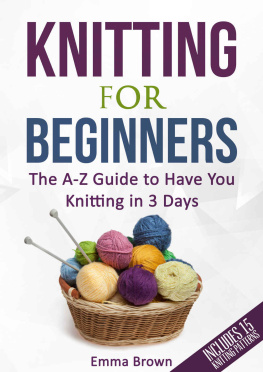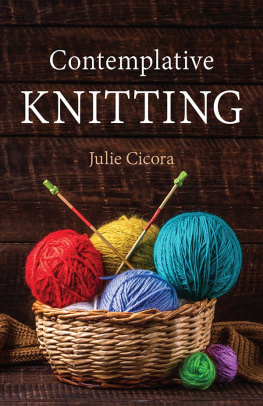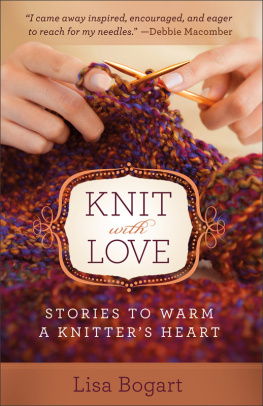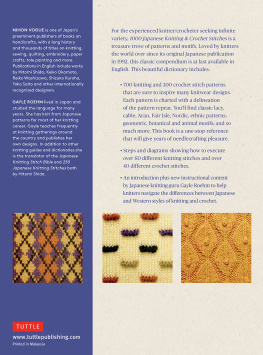The definitive book of knitting techniques
A word-of-mouth phenomenon since its original publication, with a passionate and loyal following, The Principles of Knitting has served as a treasured resource for an entire generation of knitters. Now completely revised and updated, this long-awaited new edition contains indispensable information for every knitter, from the beginner to the most experienced, on all aspects of the craft.

Written in clear, direct language, The Principles of Knitting is like having a knitting mentor by your side, ready to answer any question in a comprehensive, reasoned, and informed manner. June Hemmons Hiatt includes instructions for all facets of knitting, from the most basic skills to the most advanced techniques, and offers suggestions for best practices as well as alternatives and innovations.
The Principles of Knitting provides the inspiration and instruction to help every knitter gain the knowledge and confidence needed to produce unique, beautifully crafted garments, accessories, and household items. It is the one reference guide no knitter should be without.
The classic work on this timeless and important craft

MEET THE AUTHORS, WATCH VIDEOS AND MORE AT
SimonandSchuster.com
THE SOURCE FOR READING GROUPS
COVER DESIGN BY JODY HANSON AT WILSTED & TAYLOR PUBLISHING SERVICES COVER PHOTOGRAPHS BY COREY LESH, COREY LESH STUDIO




TOUCHSTONE
A Division of Simon & Schuster, Inc.
1230 Avenue of the Americas
New York, NY 10020
www.SimonandSchuster.com
Copyright 1988, 2012 by June Hiatt
All rights reserved, including the right to reproduce this book or portions thereof in any form whatsoever. For information address Simon & Schuster Subsidiary Rights Department, 1230 Avenue of the Americas, New York, NY 10020.
First Touchstone hardcover edition February 2012
TOUCHSTONE and colophon are registered trademarks of Simon & Schuster, Inc.
The Simon & Schuster Speakers Bureau can bring authors to your live event. For more information or to book an event contact the Simon & Schuster Speakers Bureau at 1-866-248-3049 or visit our website at www.simonspeakers.com .
10 9 8 7 6 5 4 3 2 1
Library of Congress Cataloging-in-Publication Data is available.
ISBN 978-1-4165-3517-1
ISBN-13: 978-1-45168-841-2 (eBook)
Artwork of the first edition by Kelly J. Hall, Joanna Lynch, and Beverly J. Beckman has been digitally reproduced and appears again in this edition.
Frontispiece: Photograph by Corey Lesh
To Rob and Jesse
For more than can be said
... again
Thank you for purchasing this Touchstone eBook.
Sign up for our newsletter and receive special offers, access to bonus content, and info on the latest new releases and other great eBooks from Touchstone and Simon & Schuster.

or visit us online to sign up at
eBookNews.SimonandSchuster.com
CONTENTS
INTRODUCTION TO THE SECOND EDITION
I n rereading the original introduction to this book, written more than twenty years ago, I was pleased to find that it has withstood the test of time. The sentiments and thoughts expressed there have stayed with me and seem to still be relevant.
However, two things have profoundly changed. The emergence of knitting events held nationally throughout the year and the pervasive influence of the Internet have bound knitters together in a community without boundaries; these developments sustain them in this craft to an extent that was unimaginable before.
After The Principles of Knitting went out of print in the mid-1990s, it was this community that soon began asking, emphatically, for it to be put back into their hands. It was deeply gratifying to learn how much the first edition had come to mean to so many knitters, and a deep sense of responsibility to them persuaded me to find a way to republish it.
And so ten years ago I took the first, tentative steps toward deciding what to do about this book. The physical materials necessary to reprint it had been lost, and scanning it for a facsimile was simply not an option I would consider. Therefore, the first task was to type the text back into the computer. While this might seem daunting, I type fast, and the process of doing this had the benefit of requiring careful reading of a text I had not revisited in a long time. As I worked my way through it, I gained ideas about how it might be improved for a second edition.
Initially, I thought I would rewrite about seven chapters, and then do no more than a good edit of the remaining material to polish things up a bit. That plan did not survive long. As any of you who have remodeled an old house will understand, a new kitchen can make the living and dining rooms look shabby, and then the bedrooms and bathrooms are no longer satisfying, and over time the whole house is made over and extensions added on.
So it was with the second edition of The Principles of Knitting . Techniques and concepts have been clarified and presented in ways that should make them more accessible, explanations have been rethought and instructions refined, sentences polished up and repetition rooted out, and new material added.
The book has grown to roughly 450,000 words from the previous 350,000, there are an additional 100 pages and more than 900 illustrations (still too few in this highly visual age, but as many as could be managed). The heft of this book proves that while knitting may seem to be a simple craft, there is indeed quite a lot to say about it.
Still, I must apologize for how long this has taken me. Perhaps the scale and detail justify the delay to some extent, and I can only hope that you will find it has been worth the wait. I think it is a better book: better written and better organized, and with a wonderful new design that should help you navigate through it more easily.
Those of you who are new to The Principles of Knitting will find that it is not quite like other books on techniques, and so there are suggestions here for how to best make use of it. I also want to reassure beginning knitters that the book was written with you in mind, and there is information below that should help you get started in this wonderful craft.
How to Use This Book
Most knitting books are the equivalent of cookbooks: a variety of techniques are presented with a brief description, followed by instructions and a drawing or two. In a book of that kind, you can dip in anywhere and extract something of interest without regard to what goes before or after it; each recipe, each knitting technique, stands on its own. The Principles of Knitting , both the original and this new edition, is an entirely different type of book in several respects.
It does not simply provide instructions for how to do a technique, with the expectation that you would learn in a rote fashion, but instead it provides the knowledge you need to truly master the craft. Therefore, each technique is explained ; how it works, what its characteristics are, how it can be expected to behave in the fabric, and how it compares to other, similar techniques.
Next page














